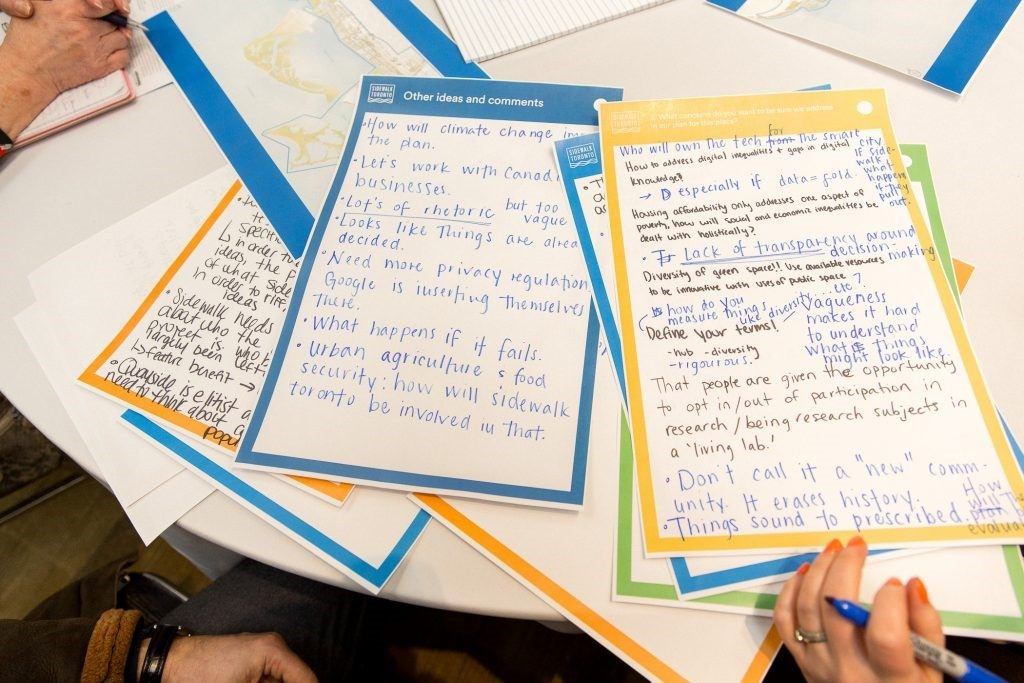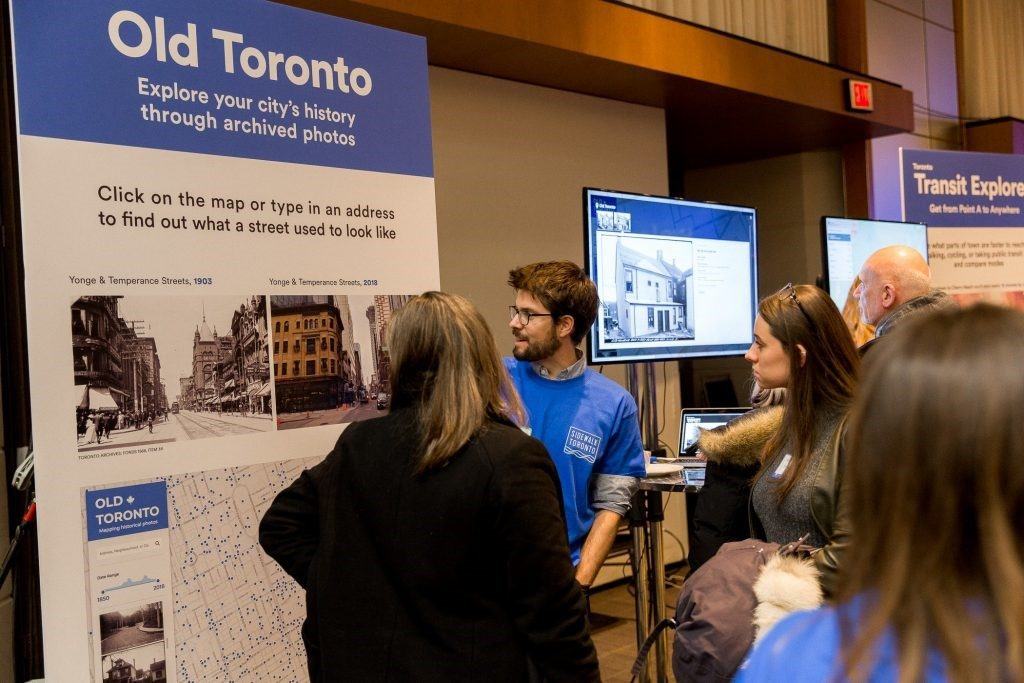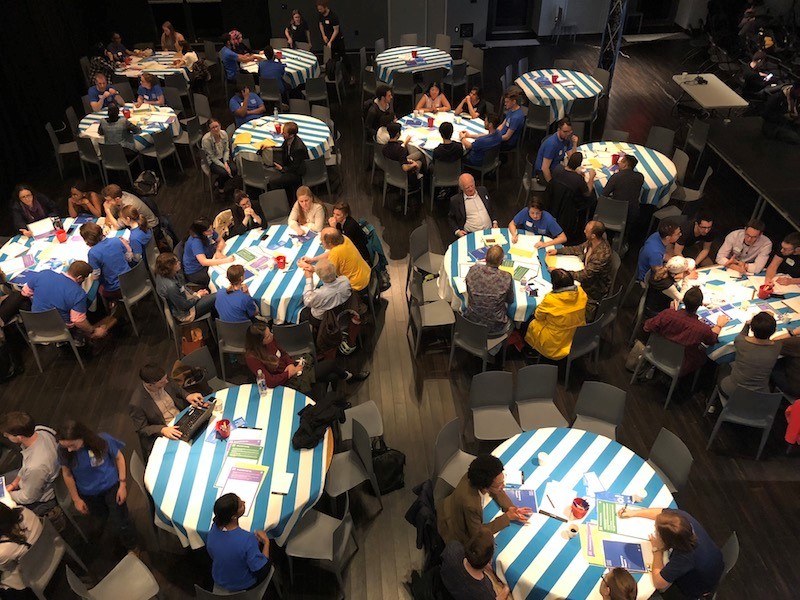Sidewalk Labs Crowdsources Citizen Input for New Toronto Waterfront Development

To create the smart cities of the future, Sidewalk Labs shows that the way forward is to ask citizens what they want, long before construction gets underway.
Sidewalk Labs, part of the Alphabet umbrella, wants to reinvent cities. In 2017, the Toronto government announced a partnership with Sidewalk: Sidewalk may develop 800 acres of Toronto’s waterfront. Sidewalk will start with a 12-acre proof-of-concept by creating a community called Quayside.[1]
Effectively, Sidewalk is developing a “product”, with technical components and lofty goals (Figure A). Sidewalk calls Quayside a “platform” wherein technology forges community.[2] Plans include embedding sensors to uptake information on traffic patterns, noise levels, air quality, energy usage, and waste output to be able to run analytics. For instance, Sidewalk could look at usage of a popup flu clinic to decide whether to place it in the same location next winter.[3]
Figure A: The physical / digital layers of Quayside.[4]
Open innovation that incorporates citizens’ ideas is key to success. Previous attempts to build ideal cities floundered without citizen input. Niemeyer’s Brasilia, for instance, designed in the 1950s, was beautiful, but as LSE Professor of Urban Studies Ricky Burdett remarked, “It’s not a city…it doesn’t have the ingredients of a city: messy streets, people living above shops, and offices near by.’”[5] Because Burdett didn’t capture organic elements of culture, Brasilia does not function according to its intended mission. Sidewalk must avoid this path.
Moreover, skeptics see Sidewalk as part of a tech giant extending surveillance capabilities from the online to the offline world. “’The smart city is a Trojan horse for technology companies…They come in under the guise of environmentalism…but they’re here for money,’” one Toronto citizen noted.[6] To gain popular support, Sidewalk must show that it is receptive to the feedback from the community.
In the short term, Sidewalk has incorporated open innovation in its development process, investing $50 million in 2018 alone for citizen input / testing.[7]
In November 2017, Sidewalk held its first town hall, where it asked questions like “how can we make Toronto a better place?” and “what excites you about Sidewalk Toronto?”[8] It ran a thematic analysis on comments, and heard five top takeaways: importance of inclusion, affordable housing, greenspace, sustainability, and working with local businesses.[9] Data privacy, public transit, and public health were also noted concerns. Sidewalk therefore prioritized solutions like designing pop-up stations and programming to engage locals, and establishing an expert advisory panel on data privacy.[10]
It then followed up with a year-long community outreach program, [11] which included 3 public roundtable sessions.[12] Guests sat in facilitated groups and heard explanations of elements like the proposed heating, “building raincoats” that would retract based on the weather, and buildings that could “grow or shrink over time”.[13] Citizens contributed to the discussion topics, which included public transit, diversity, data governance, etc.[14] Participants again gave feedback on the concepts (Figure B).
Figure B: Input from roundtable sessions.[15]
On June 16, 2018, Sidewalk also opened “307”, its Toronto workshop, where citizens experiment with elements of the vision and provide feedback.[16] Demos and installations share ideas like navigational beacons, wooden towers, and digital electricity. Sidewalk also launched a transit explorer where developers could improve on the GitHub code,[17] design jams for citizens to meet with architects to review design elements,[18] etc.
In the medium term, Sidewalk will have to source citizen input from the initial 12-acre pilot to pitch the government on developing the rest of the waterfront. Presumably it will hold more of these forums to collect metrics on satisfaction, and based on feedback, will crowdsource further ideas.
I recommend that Sidewalk be more transparent about how citizens’ ideas lead to concrete changes to the plans. Sidewalk is incorporating ideas from roundtable sessions into a Master Innovation and Development Plan, to be released in 2019;[19] it should clearly communicate specific adjustments so citizens they feel heard.
Longer term, Sidewalk should leverage feedback on its other products to inform the Toronto plan. For instance, Sidewalk recently launched a capability called Replica, which uses location data from consumers’ smartphones to inform urban planners about traffic patterns.[20] Sidewalk should state the learning from this initiative, find more creative ways to protect anonymity in the process, and publicly share insights from the data. Doing so will enable it to iterate on the vision for the rest of the Toronto waterfront so the entire community supports it.
The main issue I am uncertain about is whether this process is open innovation at its strongest; I’m not sure how vehemently Sidewalk Labs is actually using citizens’ ideas once it hears them. Is this true uptake of feedback and ideas to power new inventions, or is this a mere PR stint that Sidewalk is calling “open innovation” to make citizens feel like they had a voice in the development? (770 words)
[1] Aarian Marshal, “Alphabet is trying to reinvent the city, starting with Toronto,” Wired, October 19,2017, https://www.wired.com/story/google-sidewalk-labs-toronto-quayside/, accessed November 2018.
[2] Ian Austen, ”City of the Future? Humans, Not Technology, are the Challenge in Toronto,” The New York Times, December 29, 2017, https://www.nytimes.com/2017/12/29/world/canada/google-toronto-city-future.html, Accessed November 2018.
[3] Ibid.
[4] Laura Bliss, “When a Tech Giant Plays Waterfront Developer,” CityLab, January 9, 2018, https://www.citylab.com/design/2018/01/when-a-tech-giant-plays-waterfront-developer/549590, accessed November 2018.
[5] Robin Banerji, “Niemeyer’s Brasilia: Does it Work as a City”? BBC News, https://www.bbc.com/news/magazine-20632277, December 7, 2012.
[6] Brian Barth, “The Fight against Google’s Smart City,” The WorldPost, August 8, 2018, https://www.washingtonpost.com/news/theworldpost/wp/2018/08/08/sidewalk-labs/?noredirect=on&utm_term=.e1055a59571f, accessed November 2018.
[7] “Alphabet’s Sidewalk Labs to Start Testing Smart-City Features in Toronto this Summer,” Reuters, April 9, 2018, https://venturebeat.com/2018/04/09/alphabets-sidewalk-labs-to-start-testing-smart-city-features-in-toronto-this-summer/, Accessed November 2018.
[8] Feedback Report, Sidewalk Toronto Community Town Hall, November 1, 2017. https://sidewalktoronto.ca/wp-content/uploads/2018/04/Sidewalk-Toronto-Feedback-Report-Town-Hall.pdf, accessed November 2018.
[9] Ibid.
[10] Ibid.
[11] Monica Nickelsburg, “Alphabet’s Sidewalk Labs Reveals Plans for Toronto Innovation District Featuring Light-Up Streets and Timber Towers,” GeekWire, https://www.geekwire.com/2018/alphabets-sidewalk-labs-reveals-plans-toronto-innovation-district-featuring-light-streets-timber-towers/, Accessed November 2018.
[12] Sidewalk Labs, “Public Roundtable #4,” https://sidewalktoronto.ca/event/public-roundtable-4/, accessed November 2018.
[13] Shruti Shekar, “Sidewalk Labs Reveals Vision for ‘Smart City’ Project, Provides No Answers on Data Collection Policy,” https://www.itbusiness.ca/news/sidewalk-labs-reveals-vision-for-smart-city-project-provides-no-answers-on-data-collection-policy/104119, accessed November 2018.
[14] Sill Flessig and Dan Doctoroff, Sidewalk Toronto Public Engagement Plan, Online PDF, February 2, 2018, https://sidewalktoronto.ca/wp-content/uploads/2018/04/Sidewalk-Toronto-Public-Engagement-Plan.pdf, accessed November 2018.
[15] Sidewalk Labs, “Public Roundtable #1,” https://sidewalktoronto.ca/event/public-roundtable-1/, accessed November 2018.
[16] Will Flessig and Dan Doctoroff, Sidewalk Toronto Engagement Update, Online PDF, June 26, 2018, https://sidewalktoronto.ca/wp-content/uploads/2018/06/Sidewalk-Toronto-Engagement-Update-June2018.pdf, accessed November 2018.
[17] Sidewalk Labs, “Toronto By Public Transportation – From Point A to Anywhere,” https://www.sidewalklabs.com/blog/toronto-by-public-transportation%E2%80%8A-%E2%80%8Afrom-point-a-to-anywhere/, accessed November 2018.
[18] Ibid.
[19] Will Flessig and Dan Doctoroff, Sidewalk Toronto Engagement Update, https://sidewalktoronto.ca/wp-content/uploads/2018/06/Sidewalk-Toronto-Engagement-Update-June2018.pdf.
[20] Nick Bowden, “Introducing Replica, a Next-Generation Urban Planning Tool,” Sidewalk Talks, April 6, 2018, https://medium.com/sidewalk-talk/introducing-replica-a-next-generation-urban-planning-tool-1b7425222e9e, Accessed November 2018.







This is an interesting case where a company claims to be crowdsourcing ideas, but you can not actually see if they are. Because of this, I was happy that you wrote this post with a healthy mix of optimism and skepticism. I think you could have talked a bit more about the turnover Sidewalk Labs is experiencing with senior management and if you think that will affect the role of crowdsourcing going forward.
To agree with Jimmy Dimon, I appreciate your somewhat skeptical approach to Sidewalk Labs’ use of crowdsourcing. In many ways, it seems like a glorified town hall meeting. The Sidewalk Labs approach may have the cool bells and whistles of technology and design, but how do we make sure that the crowdsourced ideas are being implemented? How do we make sure that the voices that are contributing ideas represent the city and its culture? How do we balance what the people want with government’s plans for development? I also think we have a tendency to see some mix of technology, data, and analytics as the solution to many social issues, but there is an intangible aspect to a city and its culture that can’t be captured, replicated, or created using these tools, similar to what Ricky Burdett said.
What I do like about this scenario, is that Toronto is piloting this idea with a small plot of land, instead of going all out. Urban planning, real estate, and smart cities can be expensive. It is important to get a sense of what works well, what doesn’t, and why before dedicating expensive resources to a project like this.
While I agree with your recommendation that sidewalk labs communicate more clearly on how idea are ideas are actually incorporated, I wonder if the very nature of crowdsourcing makes that difficult. The input is only taken at the very beginning of a process without consideration for feasibility and costs. As the project moves on, the ideas have to evolve and take those factors into account that the average person may not be aware of. I think it’s worth thinking about applications where crowdsourcing is easier and harder and in situations where feasibility/costs are a big factor, how to tailor the crowdsourcing model at the right points to still be helpful.
This is a great article! It is interesting to see how Sidewalk is taking citizens’ input to make their own city what they want it to be. I agree that it is probably difficult to tie recommendations coming out of this open crowdsourcing to actual actions taken; one way to do this would be to get the names of the people submitting the ideas and follow up with them, but then you’d run in anonymity issues. On the other hand, maybe you are right that the intent is more around publicity and making citizens feel better about the city they live in. An interesting set of questions to consider!
What confuses me about these efforts is that there is little room for iteration when cities are constructed. A/B testing a website is far different than A/B testing road placement. Further, the feedback loop for a user experience in a city is far longer when considering all the factors behind being happy living in a city vs. purchasing a product/service online.
What I think Sidewalk Labs has to do is “fast prototype” as much of the city experience as possible, likely by using modular, temporary construction from relatively cheap and durable parts, and allow people to experience it. Only then will there be credibility in resident feedback. Another idea could be to try to recreate a smaller, self-contained city ecosystem for a few people to live in a longer period of time, versus allowing everyone to chime in at the “White Board” stage.
great article! what better than taking into consideration input from people before working on the next big infrastructure and help solve some of the most common mobility issues. especially in developing countries, is not often easy to identify the priority projects one should tackle first.
Interesting article!
I truly believe it is in the intersection of the private and public sectors that lies the solution to most of the current urban design issues. Therefore, I think the alliance between Sidewalk and the Toronto government is so relevant.
I agree with your recommendation that Sidewalk should be more transparent about how citizens’ ideas lead to concrete changes, but I would also be careful not to take it too far. Taking it to the extreme, crowdsourcing an infrastructure project is risky because it gives the power to take technical decisions to a group of non-technical people. This decision-making process is currently being tested in Mexico with catastrophic consequences [1].
[1] Bloomberg. https://www.bloomberg.com/news/articles/2018-10-29/mexico-votes-to-scrap-13-billion-airport-in-amlo-s-first-test
I believe the concept of open innovation will always receive a healthy level of skepticism due to it’s synergies with PR and marketing. For this case, I don’t think this is a gimmick or a way to drum up interest in the company — their sole focus is to help create cities of the future. Their strategy of collecting ideas, asking for feedback, and developing mock-ups is similar to what we saw with the IDEO case — it’s a common product development practice. I completely agree that Sidewalk should not only deliver an amazing waterfront experience, but also bring the customer along for the journey. A key aspect of IDEO’s strategy was to always keep the client in the loop — in this case, I don’t believe Sidewalk is keeping the people of Toronto fully in the loop.
The one issue that I see here, and similar to what I commented on in Ankur’s post on Amazon, is that open innovation is a sneaky way to collect data on users. However, this data is not just limited to a given project — it’s used to fuel others and obtain a competitive advantage. I now wonder: is the cost of providing this data worth having a technology-first city? Are the elected officials aware of how their decision has larger impacts?
I partly agree on your opinion that open innovation can just end as a marketing tool for the city or the companies involved in the project. The beauty of ‘Open Innovation’ or ‘Crowd sourcing’ should be linked with real changes, even with really small changes. What people really want to hear from the project is not only the solutions or the results based on their ideas, but the feedback from experts on them. Quick wins should also follow with the feedback, but Toronto should first build a bond with citizens and people involved in the project as a ‘one’ team.
There were a few projects similar to Toronto’s, but most of them ended with leaving the city as a ‘ghost city.’ (i.e. Songdo city in Korea) The amount of money spent for the project, the number of experts from the government or the level of technologies used for the project… These things cannot guarantee the success of smart project – Bottom-up/Localized initiatives are needed.